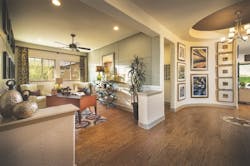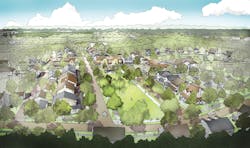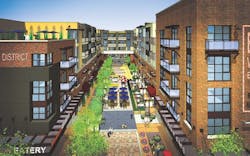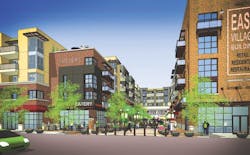Collaboration: Forming Effective Partnerships in Design
June 22, 2015
11 min read
Collaboration can be hard-won in the world of construction design. It involves no less than “independent, for-profit organizations functioning in the name of one common goal, for a limited period of time, often on a moment’s notice, with no regard for existing workload and schedules,” says Dan Gainsboro, CEO of developer NOW Communities, in Concord, Mass. “You get it when team members are inspired by the project or mission,” says Donald Powers, president of Union Studio Architecture & Community Design, in Providence, R.I.
When collaboration occurs, the result is a more marketable community that cycles through construction with a minimum of headaches. Designs can be shared, scrutinized, edited, and updated online so that everyone is aware of the latest tweaks and versions and the client is always kept in the loop.
In a collaborative atmosphere, every team member—whether on the development and construction side, the marketing side, or the design side—contributes valuable insight that will shape the best possible housing solution for that site and that market.
Of course, for such a collaboration to work, the team members must come to the table with mutual respect and a willingness to relinquish a measure of control in order to achieve a positive result. This means setting and sticking to an agenda.
“We like to pull in experts to build as much consensus as possible and make sure we’re vetting all of the possible options, but we also try to be [respectful] of everyone’s schedules,” says Tom Wulf, senior vice president of Lowe Enterprises, developer of The Garey Building in Los Angeles. “You could go on talking for days and days, but at some point a decision has to be made.”
When consultants aren’t in the same room together (physically or digitally), it’s difficult to coordinate the many parts and pieces of a project. “Some developers like to maintain control; requests have to go through them before any changes can be made,” says Rob Pressman, principal of TGP Landscape Architecture, in Burbank, Calif. “It becomes like a game of telephone where everyone hears something different.”
View a slide show of these projects, including photos, illustrations, and floor plans.
Local History Helps Shape the Vision for a New Community
Located on the site of Fort Devens, a decommissioned military base in central Massachusetts, Emerson Green will include 120 single-family detached and attached homes, as well as several multifamily buildings, clustered in a series of pocket neighborhoods.
“The site is being redeveloped as a model of sustainable housing and a campus of tech and media companies, including Bristol Myers Squibb and New England Studios,” NOW Communities’ Dan Gainsboro says. “It offers a rare opportunity to design a new neighborhood in Devens, itself once part of one of the oldest towns in Massachusetts.”
An aerial rendering shows Emerson Green, phase one of Devens, which is adjacent to a 1,700-acre nature preserve and will respect the topography and mature trees. Developer Dan Gainsboro says, "The siting is carefully considered to encourage walkability, views, and sociability and neighborhood connection." Rendering: Union Studio Architects & Community Design
Part of the Devens master plan, Emerson Green will comprise several unique neighborhoods built in phases. “We are currently working on the first 18 homes in phase one,” Gainsboro says. NOW Communities is co-developer of the master plan with Union Studio Architecture & Community Design, which is also the architect. “Those disciplines are typically separated,” notes Don Powers.
Another key team member is Robert Easton of the development firm Ajax Partners, in New York City, a strategic partner to the NOW Communities and Union Studio effort.
Taking cues from the surrounding town’s rich architectural heritage, the Emerson Green designs are inspired by the historic homes in the area. “We wanted our designs to reinforce the visual connection with the rest of the region rather than imposing buildings that detract from the stunning harmony between buildings and their views,” Powers says.
Based on the success of Concord Riverwalk, another NOW project, Gainsboro knew that planning and zoning officials would be receptive to the idea of smaller single-family houses that trade size for quality and efficiency. Marketing consultant Constantine A. Valhouli, principal of The Hammersmith Group, in New York City, says, “It’s a chance to demonstrate that a different approach to small-scale, midscale, and even larger-scale developments can be done economically and at different price points.”
At press time, site design and permitting for Emerson Green was well under way. The architecture isn’t quite at that stage, but Gainsboro and Powers have already consulted factory-built housing providers.
“Earlier versions of the architecture were designed specifically with the input of some of the likely fabricators,” Powers says. “We’ve included them in a kind of design loop [so that a culture of collaboration] is infused at every level, from the site planning all the way to the architectural details.”
“Dan and Don’s openness to sharing the thought behind the siting and design decisions is tremendously rare, in my experience,” says Valhouli, who is helping them craft a message that aligns the architecture with the site’s history, the city, and the market.
Often, Gainsboro says, people come together as a group to design a community, only to go off in separate directions. “We’re trying to leverage our shared core values and [mutual] respect to try to make a better project,” he says.
Consulting Experts for an Accurate Perspective on Aging
Victory at Verrado, in Buckeye, Ariz., was conceived by two former Del Webb executives, Nick Taratsas and Deborah Blake. Taratsas is now senior vice president with DMB, a Scottsdale, Ariz.-based developer. Blake is strategic partner for Cecilian Worldwide, in Flemington, N.J., and principal of The Ipsum Group, in Litchfield Park, Ariz., both consulting firms.
Victory is a district for active adults within the all-ages community of Verrado. When complete, it will consist of 3,500 homes on 1,200 acres. Four companies are building in phase one—Lennar Homes, Maracay Homes, Standard Pacific, and T.W. Lewis by David Weekley Homes—on lots ranging from 47 to 80 feet wide.
This well-appointed outdoor room offers scenic views of the Victory at Verrado golf course and landscape. Other homes back up to an extensive trail ssytem. Builder: T.W. Lewis by David Weekley Homes, Tempe, Ariz.; interior designer: Kathy Andrews Interiors, Houston. Image: David Weekley Homes
“We felt that the old notions of active-adult housing were based on principles that no longer are real for us,” Taratsas says. “I thought we needed to talk to people who know how the aging American thinks.”
DMB heard presentations by experts from outside the housing industry, including Dr. Walter Bortz of Stanford University (longevity and robust aging); Dr. Jim Nicolai of Andrew Weil’s Integrative Medical Institute (holistic medicine); and Georgianna Marie from Experience Matters (life and business transitioning). Next, Blake worked with ProMatura of Oxford, Miss., on consumer research that revealed what active-adult buyers want and what they are willing to pay for it.
Finally, Taratsas and Blake wooed builders that were not actively selling to the 55-and-over market. Architect Manny Gonzalez, principal of KTGY Group, in Irvine, Calif., and
universal-design expert Mary Jo Peterson, based in Brookfield, Conn., conducted a one-day seminar with nine Phoenix builders. Gonzalez and Peterson developed a pattern book containing universal-design principles and prospective elevations, vignettes, and floor plans. “We helped [the builders] understand the competitive marketplace and gave them a tool for designing homes that would be more successful with this consumer,” Blake says.
Once signed up at Victory, the builders designed new product. A few sought help from Gonzalez and Peterson. They also worked closely with Blake and Kathy Cecilian on the branding and creative strategy.
Jason Hill, president of the Phoenix division of T.W. Lewis by David Weekley Homes, in Tempe, Ariz., says that the company used information from several sources, including its in-house research and design department; Kathy Andrews Interiors, in Houston; and Helen Foster of Foster Strategy, in New Orleans, a specialist in active-adult marketing.
“All parties were part of our process from conceptual drawings to model selection, merchandising, and construction drawings,” Hill says. “We used GoToMeeting to bring together our architects and consultants in Texas and our team members either in the office or on the Victory site. Our team also met with DMB and its consultants many times.”
Peterson says, “We worked together from the beginning, which is not always the way I get brought into a project, and it was wonderful. It was the first time in 25 years that a developer said to me, ‘You tell me what I have to do.’”
Taratsas estimates that 70 percent of the planning for Victory was done early on. The amenity strategy, which involves custom-tailored fitness regimes and advanced trail systems, crystallized later as DMB consulted experts in applied functional sciences, and a new company called Avid Trails.
Mixed-Use Recharges Downtown L.A.
Lowe Enterprises, a Los Angeles-based developer specializing in large-scale, mixed-development projects, is presently at work on The Garey Building in L.A.’s Arts District. The Garey is actually two five-story buildings with 320 market-rate rental apartments over 15,000 square feet of retail. The buildings flank a two-block-long street that is being converted into a pedestrian paseo and active public space.
Apartment residents will have private amenities such as the roof deck shown here, which has views of downtown Los Angeles. Brick and steel on the exteriors reflects the industrial character of older buildings in the neighborhood. Illustration: Togawa Smith Martin Architects
Lowe’s Tom Wulf anticipates that renters will be predominantly young professionals, both singles and couples, who work in downtown L.A. “and are eager for something with a little more edginess.”
Driver Urban joined the team during conceptual design to offer preconstruction services. “We make [the project’s cost] more predictable, working with [clients] to set a budget and work toward it,” says Brian Chartrand, president of the Irvine, Calif., firm. “While the designers are designing, we’re giving constant feedback to the [client] about the pluses and minuses.” This simultaneous approach cuts down on the number of change orders and design-document delays, he adds.
Taking a Meeting: The Garey Building
With a project the scale of The Garey Building in Los Angeles, effective teamwork is a necessity, says architect Tim Smith, a partner in Togawa Smith Martin (TSM), in Los Angeles. “If you don’t have this type of interaction,” Smith says, “there’s no way that your final construction documents can be coordinated and accurate.”
The Garey Building will offer market-rate rental apartments, restaurants, and retail stores, and a central pedestrian walkway and courtyard in the Los Angeles Arts District. At the podium level are private open spaces for the apartments, which include a large courtyard with a pool and spa; barbecue grills and outdoor dining areas; and a party/gathering space around a fire pit. Illustration: Togawa Smith Martin Architects
Once the conceptual design was complete, the team met roughly every two weeks, which kept everyone on task without overburdening them.
“In the beginning we met face-to-face because we were exchanging a lot of ideas and it’s easier to sketch together,” Smith says. “[Meetings were divided into two parts] where we would meet with the various design disciplines and organize our thoughts. Then we presented those thoughts to the [client].”
In the last two phases (design development and construction documents), the team continued to meet every two weeks, though not always in person. “Some technical things were handled via GoToMeeting,” Smith says. “We’d set up an agenda a couple of days beforehand indicating who could use GoTo and who had to be there in person. If we were trying to solve a problem, we’d have the consultants come into the office."
During the preliminary design stage, meetings lasted one to two hours depending on the scope. Technical meetings lasted as long as three to four hours because there were as many as nine consultants involved; however, the meetings were sequenced so that every consultant didn’t have to be present the entire time.
TSM simplified the laborious task of taking minutes by creating a two-page, bullet-pointed project criteria list with the schedule and critical decisions for each discipline. The list was updated after every meeting. Plans, drawings, and specs were posted on TSM’s FTP site and Box.com for everyone to share.
TGP Landscape Architecture, in Burbank, Calif., got onboard early, says Rob Pressman, principal. “As soon as [TSM] had a site plan,” he says, “we were brought in to conceptualize the streetscape and courtyards.”
Audio/video and digital conferencing, which allowed team members to interact regardless of physical location, were a great advantage, Pressman says, “especially in L.A., where the traffic is just horrendous.”
About the Author

Susan Bady
Susan Bady has been writing about the housing industry for 30 years. She is senior editor of Professional Builder and Custom Builder magazines, and produces the Design Innovation e-newsletter. Bady has also written for such consumer magazines as Cabin Life and Better Homes and Gardens’ Home Plan Ideas.
Sign up for our eNewsletters
Get the latest news and updates




